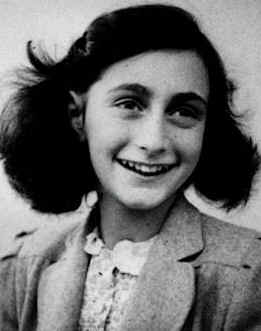Anne Frank was a Jewish girl who died in the Holocaust. She gained international fame posthumously following the publication of her diary. In her diary you can read about her experiences hiding during the German occupation during World War II.
1. The diary of Anne Frank chronicles her life from 12 June 1942 until 1 August 1944.
2. Anne Frank’s diary is one of the world’s most widely read books. In this book, the reader is able to see through the eyes of this young girl, how the holocaust affected individual Jews in hiding. Anne Frank, The Diary of a Young Girl has been translated into many different languages and is used as a part of educational curriculum in many countries of the world.
3. When it was confirmed that Anne was killed, her diary and some loose papers found in their hiding spot, were given to Otto Frank (Anne’s father). Anne had already edited her diary creating different versions with different pseudonyms. Her father read through the diary, removed some sections that he felt were inappropriate and published the original diary (eventually the edited versions would be released as well as the portions the Otto Frank edited out from the original publication). The first American edition was published in 1952 under the title Anne Frank: The Diary of a Young Girl.
4. After successfully being published, a play based upon the diary, premiered in New York City and later won a Pulitzer Prize for Drama. It was followed by the 1959 movie The Diary of Anne Frank, which was a critical and commercial success.
5. Anne Frank’s diary has been praised for its writing style and quality of work. The writing style is not only mature in the method by which content was relayed, but thoughtful in how a simple commentary was portrayed.
6. The diary of Anne Frank became a classic literary work for many reasons, one of which was its applicability to just about everyone. Although the story is of a young Jewish girl, Anne’s struggle has been likened to times of political and social unrest. For example, Nelson Mandela compared his struggle with apartheid to Anne’s struggle.
7. Anne Frank’s diary has become representative for the millions of individuals who suffered and died. She provides a voice for the six million victims of the Holocaust. Through her story we can more personally understand just how individual the Holocaust was for those who were impacted by it.
8. Anne’s father decided to publish her diary because he was aware of his daughter’s wishes to be a published author; he also felt that what she said was worth hearing. He played a key role not only in its publication, but also in the fight to secure its authenticity.
9. Anne Frank was selected as one of the “Heroes & Icons”, in Time Magazine’s June 1999 special edition titled “Time 100: The Most Important People of the Century”. Her courage and ability to honestly examine herself set her apart as a writer and a person.
10. In the late 1950’s people began denying the diary’s authenticity. Some believed that the diary was made up in an effort to shed a more sympathetic light on the plight of the Jews. Others thought it was a money-making scheme. Some could not believe that a young girl, such as Frank, was capable of writing with such maturity and claimed that the writing was that of another, older individual. All claims refuting the authenticity and legitimacy of Anne’s diary were dismissed and the genuine nature of the diary was indisputably confirmed.


Leave a Reply